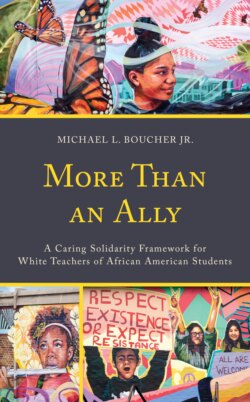Читать книгу More Than an Ally - Michael L. Boucher Jr. - Страница 5
На сайте Литреса книга снята с продажи.
No One Can Just Close the Door and Teach
ОглавлениеSullivan (2014) argued that the tendency of racially aware White people to enter spaces where they feel they can have an impact, such as a racially segregated neighborhood, does more harm than good. She argued that when these White people move into these new spaces, they express their own privilege and assume a missionary or savior standpoint (Warren & Talley, 2017). She exhorted, “Rather than setting aside one’s whiteness in an attempt to learn about other races, white people can begin to do effective racial justice work by cleaning up their own house” (p. 20).
Even in teacher education programs, because of segregated patterns of living in America, most teacher candidates have never had a meaningful exchange about race with a person racially different from themselves. It can be scary, treacherous, and unsafe to talk about race, and given the opportunity, most people avoid talking about it outside of their own racial or social groups. However, as educators devoted to students and to equity and justice in education, these uncomfortable conversations are necessary and should lead to action.
While Sullivan makes a compelling argument for self-knowledge before doing the work of dismantling privilege, White teachers working in schools with African American students have already crossed color lines and are living in the racial dynamic, meaning that inaction or delayed action is not a viable choice. White teachers in multicultural and multiracial schools do not have the luxury of deciding where and when to make a difference by waiting and assessing the situation from the sidelines. These teachers currently work across the color barrier, and thus it is not a question of whether they will influence their students and communities because, for better or worse, they do so every day.
The work of dismantling structures of oppression is currently being done in many fields and from many angles, including law, politics, policy, faith, and education. While all White people should participate in these multisided efforts, teachers have a special responsibility to care for, and about, our students and communities of color. This means that teachers must take control of the one place over which we have control, our schools.
In frustration, teachers will often say that they just close their door and do their work, effectively shutting out the cacophony outside. However, schools in a healthy republic are the gardens of democratic thinking, reasoning, and skills, not marketplaces engaged in a crass exchange of services. If anything is exchanged, it should be the narrow, flattened ideas of childhood for the complex, rich ideas of adulthood. Instead, too many view education as a value-laden transaction where those who shout the loudest are privileged in the marketplace of ideas while other voices are further marginalized.
Classrooms are the place to build a more equitable and sustainable society and should not be some neutral, or neutered, conduit for received knowledge. It is a foolish fantasy to believe that any neutrality is even possible, but to actively argue that schools should be mere conveyors of received knowledge is to reject our democratic ideals. In order to create a space where the pluralistic ethic can flourish, the mask of neutrality of culture in schools must be lifted. Thus, teachers in multicultural and multiracial schools are in the best position to do the work of dismantling structures of oppression and White supremacy and create a new, more equitable society. However, it will take more than reading the “I Have a Dream” speech every January and a bulletin board of heroes every February.
This book explains a new concept in teaching, caring solidarity. Building on the work of Gloria Ladson-Billings’s The Dreamkeepers (1994) and that of other scholars, the hope is to change the conversation about how White teachers approach teaching African American students. Solidarity with students and communities is built by replacing fear with understanding, discomfort with empathy, and avoidance with courage. Through education, care, and solidarity, educators committed to dismantling these structures move first themselves and then others to a deeper understanding and connection to empower and inspire students.
Even in teacher education programs, because of segregated patterns of living in America, most teacher candidates have never had a meaningful exchange about race with a person racially different from themselves. It can be scary, treacherous, and unsafe to talk about race, and given the opportunity, most people avoid talking about it outside of their own racial or social groups. However, as educators devoted to students and to equity and justice in education, these uncomfortable conversations are necessary and should lead to action.
